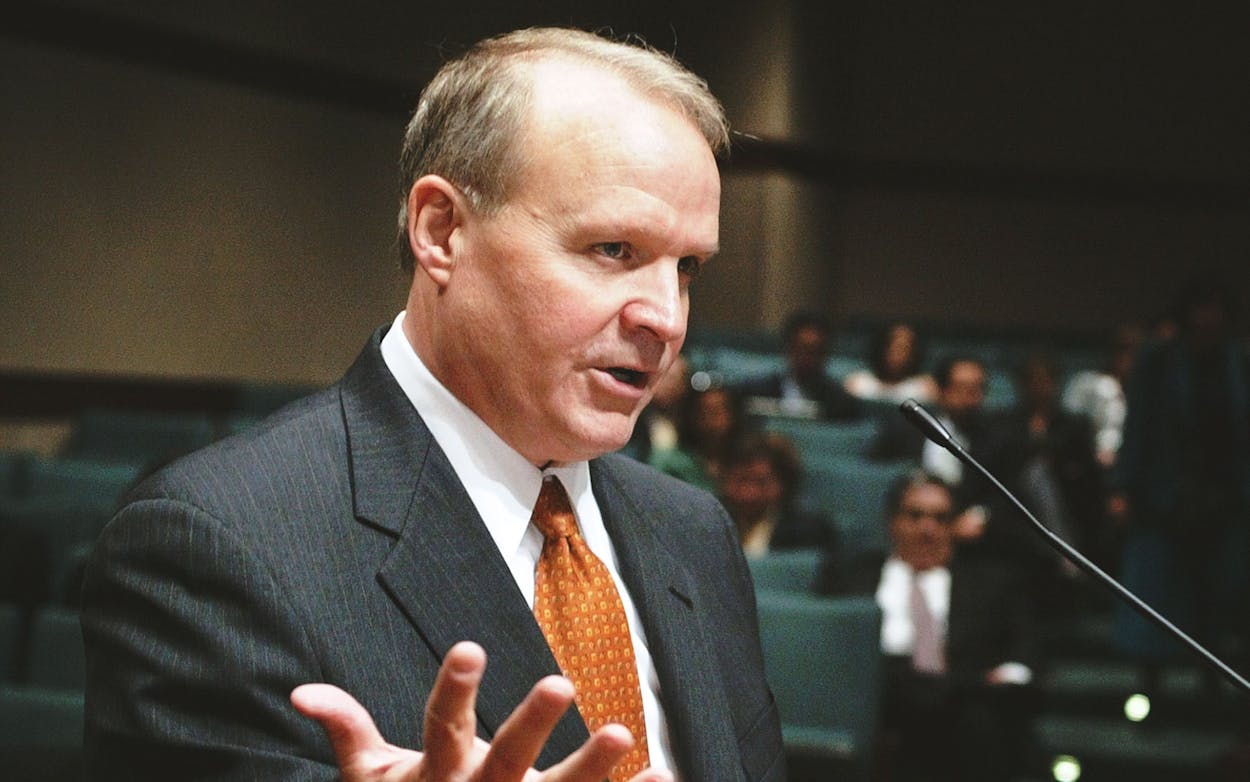Last month, the University of Texas System Board of Regents appointed Larry Faulkner to be interim system chancellor following the departure of Chancellor William McRaven, who stepped down on May 31 after a tumultuous three-and-a-half-year tenure. Faulkner, a former professor of chemistry, served as president of the University of Texas at Austin from 1998 to 2006, when he retired to become the president of the Houston Endowment, a private philanthropic foundation. Texas Monthly caught up with Faulkner on June 1, his first day in office.
Texas Monthly: Why did you decide to take the position of interim chancellor?
Larry Faulkner: The regents asked me. They needed someone to do it on an interim basis, and I’m loyal to the UT system, so I said yes.
TM: I read that you’ve taken yourself out of consideration for the full-time role. Why is that?
LF: I was never in consideration. No, I’m not the right person to do that. I’m not a long-time person.
TM: What do you see as your goal while you’re in the position?
LF: To keep things moving. You know, there’s business to do. We’re in a period where the institutions are putting their budgets together. The regents will have to assemble a budget for the UT system and adopt it in late summer. They also are going through a planning process. There will be a planning retreat that they do each year, so that’s on the agenda. There’s business to attend to, and it’s my job to see that we attend to it.
TM: You’ve also got the legislative session coming up next year. What are your top priorities?
LF: We’re sorting that out. The regents’ annual strategic retreat has to do with getting those identified clearly. The budgeting process also has a bearing on that.
TM: How would you assess Chancellor McRaven’s tenure? It was a bit shorter than most people thought it would be.
LF: I thought Chancellor McRaven brought great energy to the chancellorship. He pushed the institutions and institutional leaders to set ambitious goals, and I think there’s still energy here from the things that he set in motion. In part, my job is to make sure that that energy continues to play out productively.
TM: Chancellor McRaven got crosswise with the state political leadership on a few issues, particularly his $215 million Houston land purchase in 2016. What’s the status of the land, and what lessons did you take from that?
LF: I’m not going to comment on that. As for as the status of the land, I don’t really know. [Vice chancellor for external affairs Randa Safady, who is on the call, chimes in: “The regents have a task force working on this, and their plan is to sell the land and that the system gets, at a minimum, market value or more than that.”]
TM: What are you most proud of from your tenure as president of UT Austin?
LF: Number one is rebuilding minority representation. I came in right after the Hopwood v. Texas decision made it very difficult for us to recruit and maintain minority students, and when I arrived it was certainly true that the minority populations in the state of Texas were very negative in their view of whether UT Austin was there for them and was welcoming to them. I had to put a large priority on rebuilding our service and rebuilding the representation of minority students. We were quite successful.
TM: Between retiring as president and today, what are the biggest changes you see at UT Austin?
LF: It’s bigger and more powerful than it was. The strength of its faculty and academic programs has grown. The campus has physically grown. I think it’s just a bigger, more globally consequential place, and I’m proud to say it’s continued to make progress representing and serving the state of Texas.
TM: Last year, Texas A&M chancellor John Sharp went on the record in Texas Monthly saying the A&M system had eclipsed the UT system in a number of respects, such as growth in student population. Is UT Austin falling behind?
LF: I think UT Austin’s standing as an international institution has done nothing but become stronger and stronger in recent years. UT Austin has not been attempting to become appreciably larger. In fact, during the later stages of my tenure we tried to shrink it some. So that’s not the goal: The goal here is to become better and better. The UT System, of course, is an enormous operation serving several hundred thousand students, with seven medical centers. It has a completely different shape than the A&M System and has a different set of roles. We’re proud to be there with A&M.
TM: You spent a number of years leading the Houston Endowment after stepping down as president. What was that like?
LF: It was a terrific experience. The Houston Endowment has a very broad-based mission. It supports nonprofits in arts and culture, health and human services, the environment, and education. We looked at a spectrum of about 900 nonprofits and maintained very strong knowledge of those nonprofits. And in doing so you get to see a major metropolitan area in action. It taught me a lot about the needs of a whole society and the needs of a metropolitan area. I think it’s prepared me much better for this role than I would have been just coming out of the UT Austin presidency.








